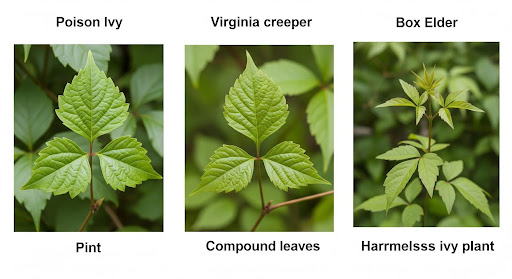Poison ivy is one of the most prevalent things that can bother people in backyards, on hiking trails, and even in metropolitan parks on the East Coast. This plant may look small, but it can create a big reaction because it makes urushiol oil, a colorless, sticky substance that causes rashes, blisters, and pain in about 85% of those who touch it.
Contents
How to Tell Poison Ivy from Other Plants
The first and most critical step in getting rid of it is to correctly identify poison ivy. Each stem of the plant usually has three pointed leaflets with smooth or jagged edges. Depending on where it grows, it can look like a climbing vine, a shrub, or ground cover.
Be careful because a lot of plants look like poison ivy. Some of these are:
- Virginia creeper (typically has five leaves)
- Boxelder seedlings have leaves that are opposite each other.
- Hog peanut and wild raspberry look same, but their stems are different.
Our Poison Ivy Free experts are highly trained to know the difference and eradicate what is dangerous for you, your family, and pets, so you can enjoy your outdoor space as a safe haven.
Why you can’t just pull out poison ivy to get rid of it
Many people think that all they have to do is pluck out the plant and be done with it. Urushiol oil is actually present in all parts of the plant, including the leaves, stems, and roots. It can stay active on surfaces for months, which makes it dangerous to handle it wrong.
Here are some important strategies for getting rid of poison ivy safely and well:
- Wear protective gear like long sleeves, pants, gloves, and even goggles to keep your skin safe.
- Don’t touch your face. After you touch a plant you don’t know, wash your hands and clothes right away.
- Clean tools. To get rid of any urushiol that could still be on your tools, use rubbing alcohol or degreasing soap.
- Never burn poison ivy. Breathing in urushiol particles from smoke can cause serious problems with your lungs.
How to Get Rid of Poison Ivy Residue
Urushiol oil can stick to clothes, pet hair, gardening tools, and even doorknobs. That’s why taking the plant out isn’t enough; you also need to get rid of the residue.
Here are some tips for neutralizing residue:
- Use hot water and detergent to wash clothes that have been contaminated.
- Use isopropyl alcohol or specific cleansers to clean tools and surfaces.
- Use pet-safe wipes or shampoos to wash pets that may have walked through poison ivy.
- How to Get Rid of Poison Ivy Residue: More Information Here
Removing Chemicals vs. Natural
Some people like to use vinegar, salt, or boiling water to kill plants themselves; however, these methods sometimes hurt nearby plants and don’t completely kill the plant’s roots. Chemical herbicides can work better, but they need to be used properly and may need to be used more than once.
Professional services employ specific methods to safely and completely break down urushiol without hurting the environment.
Why You Might Get Rashes Over and Over
Poison ivy can come back from roots that are still there or seeds that birds have carried. If urushiol is left on your clothes or surfaces at home, you may still develop rashes even if you don’t come into contact with the plant again.
Reactions that happen over and over again are often caused by:
- Not completely taking out roots
- Touching dirty surfaces
- Infestations nearby that are spreading below the earth
When to Get Help from a Pro
If the infestation is big, hard to find, or in a sensitive area (such as near play structures or pet runs), the best thing to do is call in an expert. Poison Ivy Free has been getting rid of poison ivy for a long time, throughout the East Coast. Their skilled crews know how to find, get rid of, and stop poison ivy from growing in homes and businesses.
Do Something Before the Itch Starts
If you own a home, manage property, or just like spending time outside, it’s important to know how to spot, remove, and clean up after coming into contact with poison ivy. Do anything before a rash shows up.
Go to Poison Ivy Free today to find out more about safe and effective ways to get rid of poison ivy, or set up a meeting with their team of experts.
